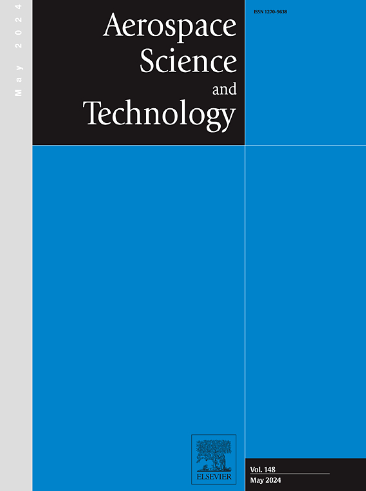基于等相对旋转加速度反演法的涡扇发动机加速度控制方案研究
IF 5.8
1区 工程技术
Q1 ENGINEERING, AEROSPACE
引用次数: 0
摘要
现有的加速度控制计划设计方法只关注加速度时间,而忽略了加速度结束时显著的超调和推力波动,这些都会对实际飞行产生不利影响。为了获得更好的实际飞行效果,本研究旨在开发一种改进的加速度控制方案,在控制加速度末端扰动的同时最小化加速度时间。为此,提出了等相对旋转加速度反演方法(EARM)。首先建立了动态稳态反向模型(DSRM),实现了目标旋转加速度和速度的动态性能仿真。然后,引入搜索增强策略-混沌粒子群优化(SES-CPSO)算法来解决与DSRM相关的复杂优化问题。在此基础上,通过对双转子加速过程的协调规划,对多个控制变量进行优化,得到多变量控制方案。仿真结果表明,在H = 0 km, Ma = 0工况下,与瞬态反求法(TRM)设计方案相比,加速时间从3.86 s减少到3.71 s,减小了4.04%,推力超调量从2.76%减少到0.665%,减小了75.91%。结果表明,该方法能有效地减小加速度结束时转速和推力的波动和超调,同时使加速度时间最小化。本文章由计算机程序翻译,如有差异,请以英文原文为准。
Research on acceleration control schedule for turbofan engine based on equal relative rotational acceleration reverse method
Existing design methods for acceleration control schedules focus only on acceleration time, neglecting significant overshoot and fluctuation in thrust at the end of acceleration, which can adversely affect actual flight. To achieve better actual flight effects, this study aims to develop an improved acceleration control schedule that simultaneously minimizes acceleration time while controlling end-of-acceleration disturbances. Toward this goal, the Equal Relative Rotational Acceleration Reverse Method (EARM) is proposed. Initially, the Dynamic Steady Reverse Model (DSRM) is established to achieve dynamic performance simulation of the target rotational acceleration and speed. Then, the Search Enhancement Strategies-Chaotic Particle Swarm Optimization (SES-CPSO) algorithm is introduced to tackle the complex optimization problems associated with the DSRM. Based on the above two, by coordinately planning the dual rotor acceleration process, an optimization of multiple control variables is conducted to obtain a multivariable control schedule. Simulation results show that under the condition of H = 0 km, Ma = 0, compared with the schedule designed by the Transient-state Reverse Method (TRM), acceleration time is reduced from 3.86 seconds to 3.71 seconds, a reduction of 4.04%, and thrust overshoot is reduced from 2.76% to 0.665%, a reduction of 75.91%. It is concluded that the proposed method can effectively reduce the fluctuation and overshoot of rotational speeds and thrust at the end of acceleration while minimizing the acceleration time.
求助全文
通过发布文献求助,成功后即可免费获取论文全文。
去求助
来源期刊

Aerospace Science and Technology
工程技术-工程:宇航
CiteScore
10.30
自引率
28.60%
发文量
654
审稿时长
54 days
期刊介绍:
Aerospace Science and Technology publishes articles of outstanding scientific quality. Each article is reviewed by two referees. The journal welcomes papers from a wide range of countries. This journal publishes original papers, review articles and short communications related to all fields of aerospace research, fundamental and applied, potential applications of which are clearly related to:
• The design and the manufacture of aircraft, helicopters, missiles, launchers and satellites
• The control of their environment
• The study of various systems they are involved in, as supports or as targets.
Authors are invited to submit papers on new advances in the following topics to aerospace applications:
• Fluid dynamics
• Energetics and propulsion
• Materials and structures
• Flight mechanics
• Navigation, guidance and control
• Acoustics
• Optics
• Electromagnetism and radar
• Signal and image processing
• Information processing
• Data fusion
• Decision aid
• Human behaviour
• Robotics and intelligent systems
• Complex system engineering.
Etc.
 求助内容:
求助内容: 应助结果提醒方式:
应助结果提醒方式:


